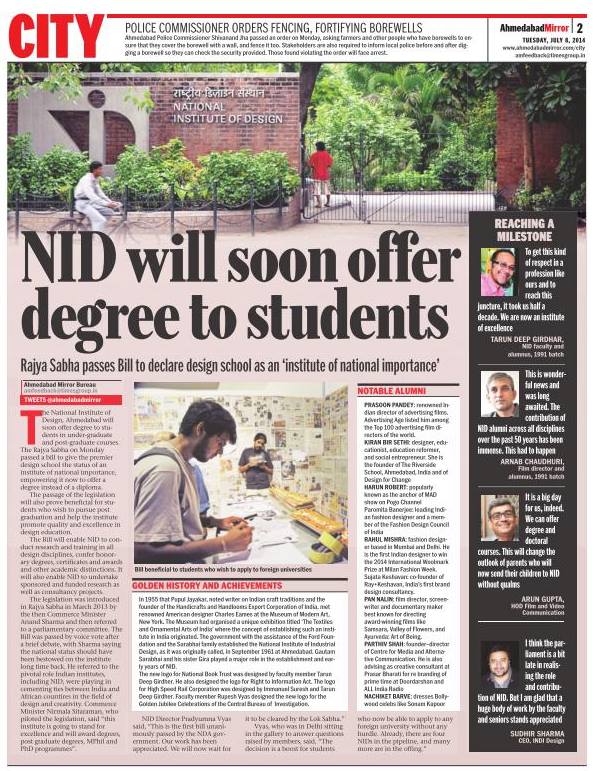Design education in India just went one step higher in terms of more acceptance from the society and the people in the government. The realisation of the importance and role of design in the development of the society is important. So, in my opinion, the recent passing of the NID bill in the Rajya Sabha, to declare NID as a institute of National Importance is a landmark thing. NID being the oldest design institute in India, had to get this. Today as I write this, there is more hope for design in India than ever before. This is driven not just from the perspective of education, but also the industry relations.
- The bill will also enable the NID to undertake sponsored and funded research as well as consultancy projects.
- It will enable the NID to conduct research and training in all disciplines related to design.
- It would allow the NID to confer honorary degrees, diploma, certificates and awards and other academic distinctions and titles in disciplines relating to design.
- The institute will now be able to award degrees to its students.
- Also be able to open PhD Programs in Design. This was earlier being offered only by IITGuwahati, IIT Bombay and more recently Srishti school of Design (through Manipal University)
Image courtesy: Times of India, epaper.

I hope that the NID rewards the degree of Bachelor of Design, (BDes) the same that is being given to students at the IIT Guwahati, NIFT and other deemed universities undergraduate programs. Ever since I got that BDes degree from the IIT Guwahati in 2005, I have wanted to see more people in my tribe. Though I have never faced any problem in my professional career, it was a bit difficult to explain the BDes degree to many, especially in areas of the country, where only BTech or MBBS or MBA are the degrees that they have heard of.
What we need now is a regulatory body to approve and look at the developments of Design Institutes in India. Technical, Management, Dental, Medical, Architecture education all has its regulatory body, but Design so far does not have one. Considering the amount of requirement that we have, I thing we are highly short on the number of design schools here. However care has to be taken to ensure that it does not go the engineering / management way of just increasing the numbers, compromising on quality. It was hoped that the India Design Council, would have that role of being the regulatory body, but its not been the case so far.
The Vision first series of discussions with the earlier government on the role of Design in the country and Visioning Design Innovation Centres to come up in the country. This does not directly translate to the setting up of more design colleges. Centres of excellence in Design, can be set up in numerous of the existing engineering and management colleges as well. A lot of the new IITs being set up have been involved in this process. I know of this happening atleast at the Disruptive Design course at IIT Gandhinagar and Department of Design at IIT Hyderabad. The setting up of the DLabs by Indian School of Business, and its project of taking Design Workshops at Engineering colleges in India is commendable.
With the new government settling in, A Balasubramaniam, in his post (an open letter to the new Prime Minister Modi) also writes about the possibility of a setting up of a ministry of Design in India.
- The expectations are mounting and so are the problems. I want to draw your attention to do something dramatic, as is expected of you. Please create a new ministry: Ministry of Design.
- The Ministry of Design can be the agent of change that you want to see. And you can count on the design community to join you in this cause.
These are all good signs for the progress of Design and Design education in India. The days ahead are challenging, because we need more professionals to get involved. It is good to see more professionals willing to come to Design colleges and spend time with the students. But the time is right to also make being in the design education field also a good career choice for designers.

One Comment
Perhaps the design curriculum needs some evolution also. The role of Big Data analysis and ability to deal with a multitude of sensors will become important in the context of next generation designs. Of course, there are new technologies like 3D printing etc. which are tending to become part of our daily lives and are likely to influence design. On the sidelines is Nanotechnology, a technology waiting for an application.